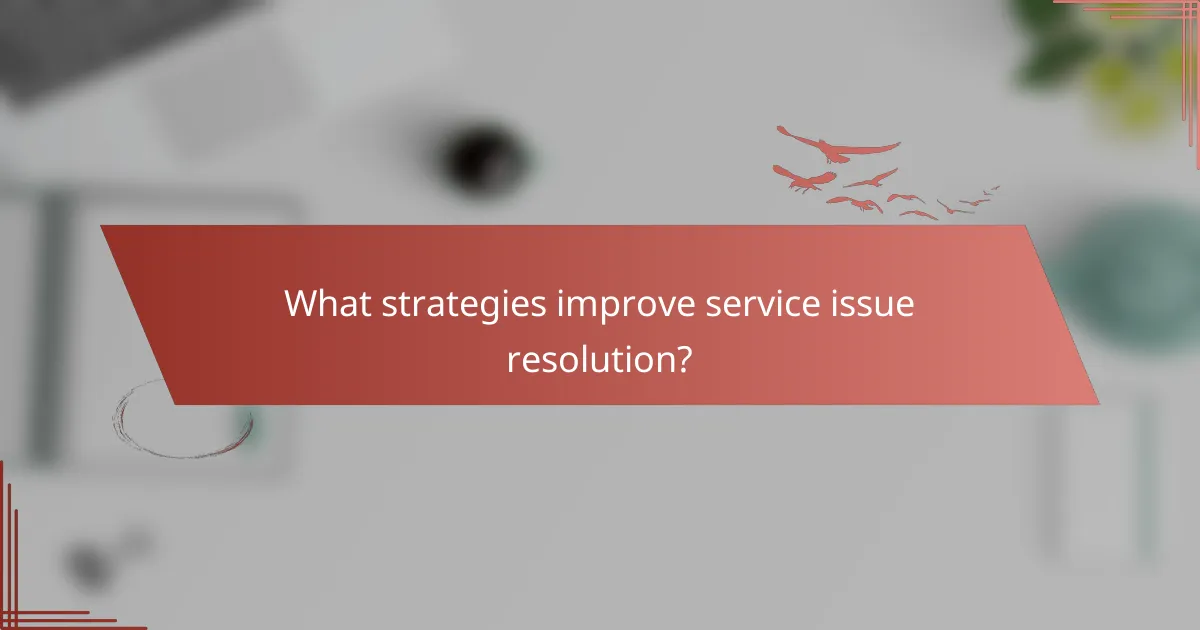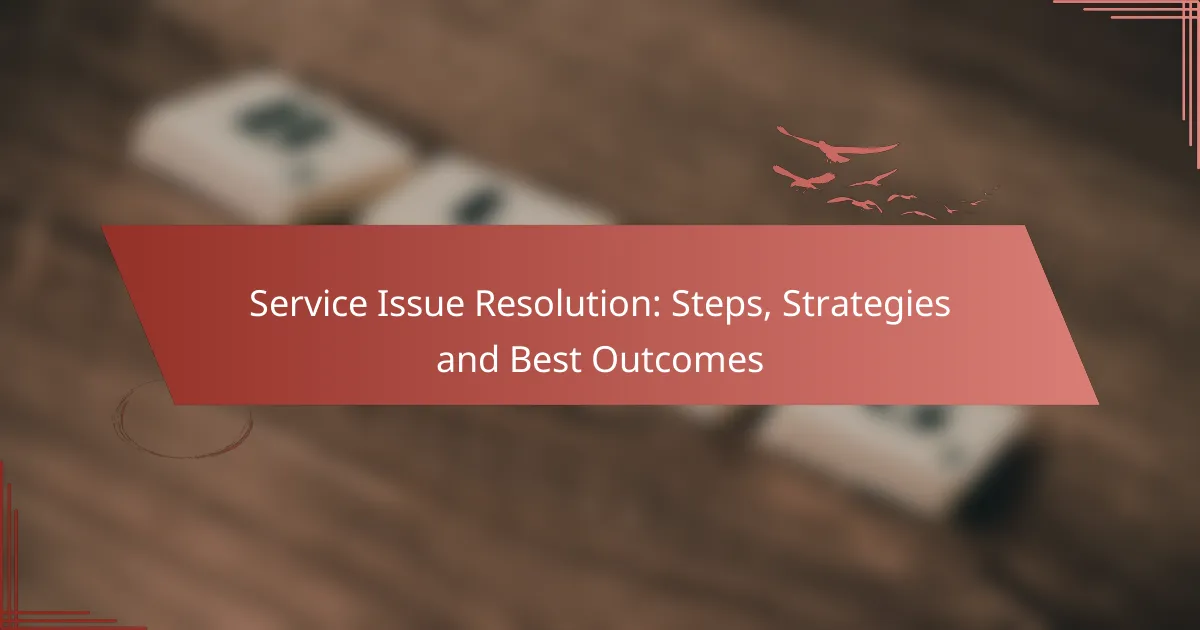Effective service issue resolution is crucial for maintaining customer satisfaction and loyalty. By following a systematic approach and employing strategic communication, businesses can address concerns promptly and efficiently. Leveraging technology and staff training further enhances the resolution process, leading to improved outcomes for both customers and service providers.

What are the steps for effective service issue resolution?
Effective service issue resolution involves a systematic approach to identify and address customer concerns promptly. Following a clear set of steps can enhance customer satisfaction and improve service quality.
Identify the issue
Identifying the issue is the first crucial step in resolving service problems. This involves listening carefully to the customer’s description of the problem and asking clarifying questions to fully understand the situation.
Common issues may include product defects, service delays, or billing errors. Recognizing the specific nature of the complaint allows for a more targeted response.
Gather necessary information
Once the issue is identified, gather all relevant information to assess the situation effectively. This may include customer account details, transaction records, and any previous correspondence related to the issue.
Utilizing a checklist can streamline this process. Key items to collect include customer contact information, service dates, and any documentation that supports the claim.
Communicate with the customer
Effective communication with the customer is vital throughout the resolution process. Acknowledge their concerns and provide updates on the progress of their issue.
Use clear, concise language and avoid jargon. Regularly check in with the customer to ensure they feel heard and valued, which can help build trust and rapport.
Implement a solution
After gathering information and communicating with the customer, implement a solution tailored to the identified issue. This could involve repairing a product, issuing a refund, or providing a service credit.
Ensure that the solution aligns with company policies and is feasible within the given timeframe. Document the steps taken to resolve the issue for future reference.
Follow up
Following up after a solution is implemented is essential to ensure customer satisfaction. Reach out to the customer to confirm that the issue has been resolved to their satisfaction and to address any remaining concerns.
This step not only reinforces the customer’s trust in your service but also provides valuable feedback for improving future service interactions. Consider sending a brief survey to gauge their experience and gather insights for continuous improvement.

What strategies improve service issue resolution?
Effective service issue resolution relies on strategies that enhance communication, leverage customer insights, and ensure staff are well-trained. Implementing these approaches can lead to quicker resolutions and improved customer satisfaction.
Proactive communication
Proactive communication involves reaching out to customers before they encounter issues, providing updates, and offering assistance. This strategy can prevent misunderstandings and build trust, as customers feel valued and informed.
For example, sending notifications about service outages or maintenance can prepare customers for potential disruptions. Regular check-ins can also help identify issues before they escalate, allowing for timely resolutions.
Utilizing customer feedback
Utilizing customer feedback is crucial for understanding service issues and improving resolution processes. Actively soliciting feedback through surveys or direct conversations can reveal pain points and areas for improvement.
Consider implementing a system to track feedback trends over time. This can help identify recurring issues and inform adjustments to services or policies, ultimately enhancing the overall customer experience.
Training staff effectively
Effective staff training equips employees with the skills and knowledge needed to resolve service issues efficiently. Training should cover not only product knowledge but also communication skills and problem-solving techniques.
Regular training sessions, role-playing scenarios, and updates on new policies can keep staff prepared for various situations. Investing in staff development can lead to faster resolutions and a more confident team, positively impacting customer satisfaction.

How can technology enhance service issue resolution?
Technology can significantly improve service issue resolution by streamlining processes, enhancing communication, and providing valuable data insights. By implementing various tools, businesses can respond more efficiently to customer needs and resolve issues faster.
Customer relationship management (CRM) tools
CRM tools centralize customer information, allowing service teams to access detailed histories and preferences. This enables personalized interactions and quicker resolutions, as agents can understand the context of issues without needing extensive background checks.
When selecting a CRM, consider features like integration capabilities, user-friendliness, and analytics. Popular options include Salesforce, HubSpot, and Zoho, which can cater to different business sizes and needs.
Automated ticketing systems
Automated ticketing systems streamline the process of tracking and managing service requests. These systems categorize issues, assign them to the appropriate team members, and monitor progress, ensuring nothing falls through the cracks.
Look for ticketing solutions that offer customizable workflows and reporting features. Tools like Zendesk and Freshdesk can help businesses improve response times and customer satisfaction by providing clear visibility into ongoing issues.
Chatbots for initial support
Chatbots can handle initial customer inquiries, providing instant responses to common questions and issues. This reduces the workload on human agents and allows them to focus on more complex problems that require personal attention.
When implementing chatbots, ensure they are programmed with a comprehensive knowledge base and can escalate issues to human agents when necessary. This hybrid approach can enhance customer experience while maintaining efficiency in service operations.

What are the best practices for service issue resolution in the UK?
Effective service issue resolution in the UK involves personalized interactions, clear communication, and structured escalation paths. These practices ensure that customer concerns are addressed promptly and satisfactorily, leading to improved customer loyalty and satisfaction.
Personalized customer interactions
Personalized customer interactions are crucial for effective service issue resolution. Tailoring responses to individual customer needs fosters a sense of value and understanding. For instance, addressing customers by name and acknowledging their specific issues can significantly enhance their experience.
To implement personalized interactions, train staff to actively listen and empathize with customers. Encourage representatives to take notes during conversations to remember key details for future interactions. This approach not only resolves issues more effectively but also builds long-term relationships.
Clear escalation paths
Clear escalation paths are essential for resolving service issues efficiently. Customers should know how to escalate their concerns if initial resolutions are unsatisfactory. Providing a straightforward process helps manage expectations and reduces frustration.
Establish a tiered support system where issues can be escalated to higher levels of expertise as needed. Clearly communicate these paths to customers, perhaps through FAQs or support documentation. This transparency can lead to quicker resolutions and a more positive overall experience.

What metrics should be tracked for service issue resolution?
Key metrics for service issue resolution include resolution time and customer satisfaction scores. Tracking these metrics helps organizations assess their efficiency in addressing issues and the overall experience of their customers.
Resolution time
Resolution time measures how long it takes to resolve a service issue from the moment it is reported. This metric is crucial as it directly impacts customer satisfaction; shorter resolution times generally lead to happier customers. Aim for resolution times in the low single-digit minutes for minor issues and a few hours for more complex problems.
To effectively track resolution time, consider using automated systems that log timestamps for when issues are reported and resolved. Regularly review this data to identify trends and areas for improvement, such as peak times when issues arise or specific types of issues that take longer to resolve.
Customer satisfaction scores
Customer satisfaction scores (CSAT) gauge how satisfied customers are with the service they received after an issue is resolved. This metric is typically collected through surveys immediately following resolution and can provide insights into the effectiveness of your service processes. A CSAT score of 80% or higher is often considered a strong indicator of customer approval.
To improve CSAT scores, focus on training staff to communicate effectively and empathetically with customers. Additionally, consider implementing follow-up procedures to ensure that customers feel valued and heard, which can enhance their overall experience and loyalty.
